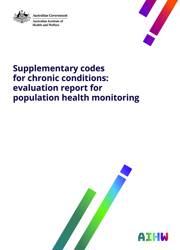Summary
The International Statistical Classification of Diseases and Related Health Problems, 10th revision, Australian Modification (ICD-10-AM) is used to classify diseases, injury and related health problems in admitted patient care data in Australia.
In July 2015, 29 supplementary codes for chronic conditions (U78–U88), and a new Australian Coding Standard (ACS 0003 Supplementary codes for chronic conditions) were implemented in the Ninth Edition of ICD-10-AM.
The introduction of these codes has implications for the monitoring of chronic conditions using hospitalisation data in Australia. This report uses data from the National Hospital Morbidity Database and the National Dementia Linked Dataset to evaluate the use of the supplementary codes for the purpose of population health monitoring and provide evidence for including these codes in future analysis and linked data assets.
Key findings include:
- 1 in 3 hospitalisations in 2019–20 had at least one supplementary code.
- One-third of the conditions for which supplementary codes were introduced in 2015–16, had a marked drop in additional diagnoses in that year.
- Including supplementary codes in analyses increases the capture of some chronic conditions up to 15-fold in unlinked hospitalisations data and 9-fold in available linked hospitalisations data.
- Supplementary codes are only being assigned in a minority of hospitalisations of people who have a prior record of a diagnosis or supplementary code for the chronic condition.
The supplementary codes provide unique information about chronic conditions in the hospitalised population beyond principal and additional diagnoses and should be used in routine analyses and health research. The value of this unique information to the monitoring of chronic conditions and associated work would be greatest if included in analysis of linked data.
Box 1: Key definitions
Supplementary code: A supplementary code is assigned for chronic conditions that are part of the current health status on admission that do not meet criteria for inclusion as a principal or additional diagnosis on the patient’s hospital record.
Principal diagnosis: The diagnosis established after study to be chiefly responsible for occasioning an episode of admitted patient care.
Additional diagnosis: A condition or complaint either coexisting with the principal diagnosis or arising during the episode of admitted patient care which is significant in terms of treatment required, investigations needed and resources used in each episode of care. Multiple diagnoses may be recorded.
Summary
Introduction
- Background
- Project phases
- Aims
- Rationale
Methods
- Ethics and approvals
- Data sources
- Study population
- Key definitions
- Classifications and mapping
- Measures
- Patterns and trend analysis
- Chronic condition capture analysis
- Consistency of chronic condition coding analysis
- Report structure
Section 1: Trends in supplementary code utilisation from 2015–16 to 2019–20
- Demographic characteristics
- Hospitalisation characteristics
- Hospital location
- Sector
- Length of stay
- By supplementary code
Section 2: Chronic conditions recorded as supplementary codes
- Summary of findings;
- Detailed results by supplementary code
Section 3: Supplementary codes for use in monitoring chronic conditions
- Summary of findings;
- Chronic condition capture in hospitalisations data
- Capture of pre-established chronic conditions with supplementary codes
- Detailed results by supplementary code
Conclusion and recommendations
End matter: Recommendations, Acknowledgements, Glossary, Abbreviations; Data sources, References.



